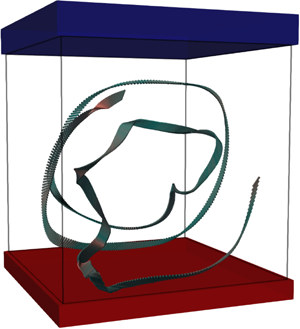Crossref Citations
This article has been cited by the following publications. This list is generated based on data provided by
Crossref.
Fu, Jianhong
Chen, Sheng
Chen, Pinzhuo
and
Wen, Chang
2021.
Particle-resolved simulation on viscous flow past random and ordered arrays of hot ellipsoidal particles.
International Journal of Multiphase Flow,
Vol. 142,
Issue. ,
p.
103736.
Jiang, Linfeng
Wang, Cheng
Liu, Shuang
Sun, Chao
and
Calzavarini, Enrico
2021.
Rotational dynamics of bottom-heavy rods in turbulence from experiments and numerical simulations.
Theoretical and Applied Mechanics Letters,
Vol. 11,
Issue. 1,
p.
100227.
Alipour, Mobin
De Paoli, Marco
Ghaemi, Sina
and
Soldati, Alfredo
2021.
Long non-axisymmetric fibres in turbulent channel flow.
Journal of Fluid Mechanics,
Vol. 916,
Issue. ,
Wang, Cheng
Yi, Lei
Jiang, Linfeng
and
Sun, Chao
2022.
How do the finite-size particles modify the drag in Taylor–Couette turbulent flow.
Journal of Fluid Mechanics,
Vol. 937,
Issue. ,
Liu, Zehua
Jiang, Linfeng
and
Sun, Chao
2022.
Accumulation and alignment of elongated gyrotactic swimmers in turbulence.
Physics of Fluids,
Vol. 34,
Issue. 3,
Cui, Zhiwen
and
Zhao, Lihao
2022.
Shape-dependent regions for inertialess spheroids in turbulent channel flow.
Physics of Fluids,
Vol. 34,
Issue. 12,
Fu, Jianhong
Jiang, Kaijun
Chen, Sheng
and
Du, Xiaoze
2022.
Effect of large temperature difference on drag coefficient and Nusselt number of an ellipsoidal particle in compressible viscous flow.
Powder Technology,
Vol. 408,
Issue. ,
p.
117766.
Jayaram, Rohith
Jie, Yucheng
Zhao, Lihao
and
Andersson, Helge I.
2022.
Preferential orientation of tracer spheroids in evolving Taylor–Green vortex flow.
Physics of Fluids,
Vol. 34,
Issue. 4,
Jiang, Linfeng
Wang, Cheng
Liu, Shuang
Sun, Chao
and
Calzavarini, Enrico
2022.
Dynamics of finite-size spheroids in turbulent flow: the roles of flow structures and particle boundary layers.
Journal of Fluid Mechanics,
Vol. 939,
Issue. ,
Wang, Cheng
Jiang, Linfeng
and
Sun, Chao
2023.
Numerical study on turbulence modulation of finite-size particles in plane-Couette flow.
Journal of Fluid Mechanics,
Vol. 970,
Issue. ,
Jayaram, Rohith
Jie, Yucheng
Zhao, Lihao
and
Andersson, Helge I.
2023.
Dynamics of inertial spheroids in a decaying Taylor–Green vortex flow.
Physics of Fluids,
Vol. 35,
Issue. 3,
Crewdson, Georgie
and
Lappa, Marcello
2023.
Three-dimensional solid particle self-assembly in thermovibrational flow: The case with unidirectional temperature gradient and concurrent vibrations.
Physics of Fluids,
Vol. 35,
Issue. 2,
Raza, Saad
Hirata, Silvia C.
and
Calzavarini, Enrico
2024.
Stabilization of the Rayleigh–Bénard system by injection of thermal inertial particles and bubbles.
Physics of Fluids,
Vol. 36,
Issue. 12,
Giurgiu, Vlad
Caridi, Giuseppe Carlo Alp
De Paoli, Marco
and
Soldati, Alfredo
2024.
Full Rotational Dynamics of Plastic Microfibers in Turbulence.
Physical Review Letters,
Vol. 133,
Issue. 5,
Lote, Dhiraj A.
Yang, Xin
Khalij, Mohammed
Arcen, Boris
Tanière, Anne
and
Mao, Xuerui
2025.
The Nusselt number and the aerodynamic coefficients for prolate and cylindrical particles at low to moderate Reynolds number.
Powder Technology,
Vol. 464,
Issue. ,
p.
121131.


